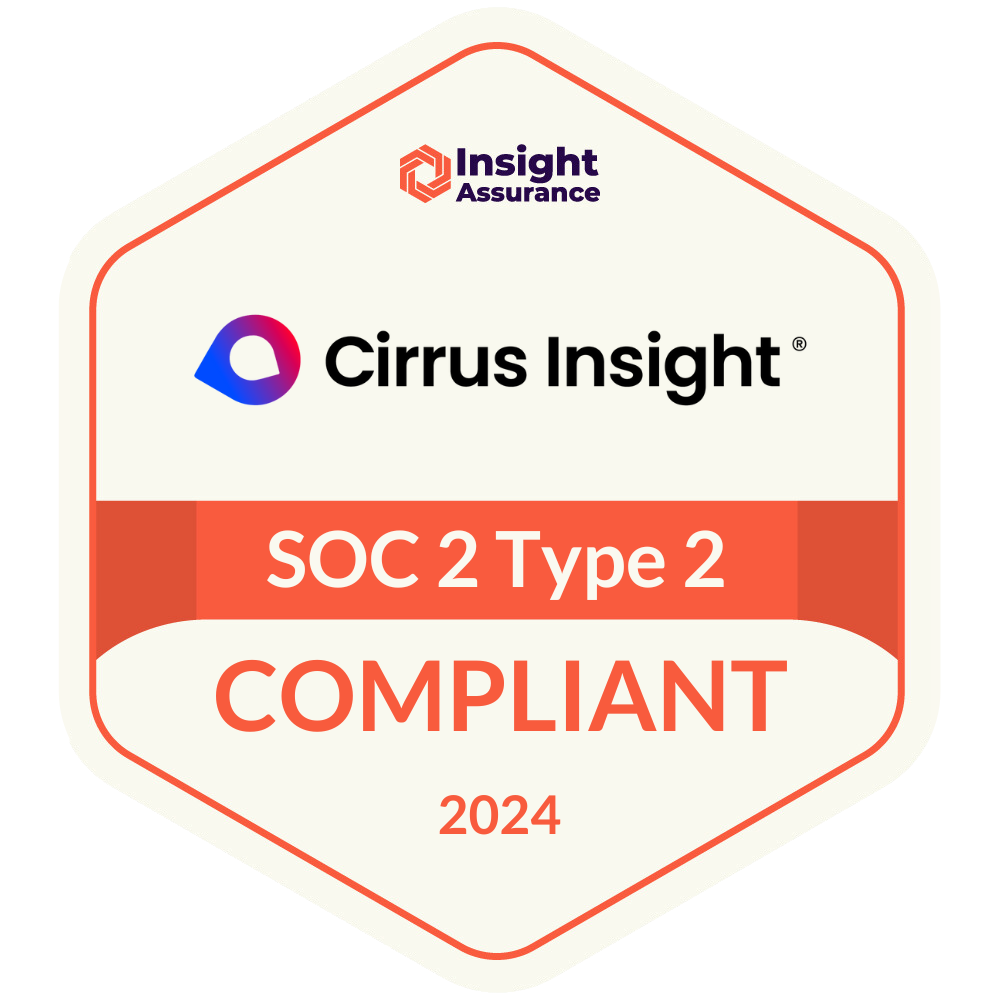- Solutions
-
Products
-
Resources
Sales Automation Tools | Cirrus Insight by Kristi Campbell View all Blog Posts >Get the App, Get the Sidebar, & Get Your Trial Going HereUnleash limitless growth opportunities by partnering with Cirrus Insight.
- Pricing
Filter By:
- All topics
- Sales Productivity
- Sales Intelligence
- Salesforce
- Sales Strategy
- Sales Prospecting
- Book More Meetings
- Best of
- Company News
- Product
- Sales Leadership
- CRM Admininstration
- Sales Metrics
- Supercharge Sales Activity
- Team Scheduling
- Admin
- serious insights
- Prospect Smarter
- Sales Activity Data
- Sales Forecasting
- Scheduling Solutions
- Prospect Faster
- Auto-Sync Everything To Your CRM
- Chrome
- Comparison
- Financial Services
- For Admins
- Getting Started
- IT & Security
- outlook
Subscribe to our Blog for the Latest Insights
Join our blog community to stay informed and receive fresh content and actionable tips directly in your inbox.
How to Use Sales Activity Tracking to Boost Close Rates
.jpg?width=830&height=553&name=pexels-pixabay-265087%20(1).jpg) There’s no second-guessing. A high-performing sales team is one of the main reasons behind a business’s growth because the higher the close rates, the greater the revenue.
There’s no second-guessing. A high-performing sales team is one of the main reasons behind a business’s growth because the higher the close rates, the greater the revenue.
So, evaluating sales performance is key to boosting your organization’s close rates and staying ahead of the game. But where do you start?
Activities in sales are small yet significant indicators of a smooth sales pipeline. They are a huge part of your sales reps’ everyday tasks, apart from tackling numerous issues and activating channels. This manual effort can lead to inefficiency in tracking activities and their impact on overall performance.
Here’s where sales activity tracking comes into the picture. This article will discuss what it is and how to track activities correctly.
What is sales activity tracking?
Sales activity tracking is the process of documenting and monitoring the various efforts of your salespeople.
The main intention behind this form of tracking is to help your sales reps have smoother transitions within the sales pipeline and to boost performance.
Sales activity tracking primarily involves tracking two types of activities, i.e., quantitative and qualitative. The former is based on raw numbers, while the latter gives you the ‘what’ and ‘why’ of your sales activities. For example
How are your sales reps blocking their time for calls?’
‘What is their process for handling a cold call?’
Here are some essential quantitative metrics you can track for daily sales activities:
- Deals won or lost
- Emails sent and received with response rates
- Calls made and received
- Conversion rates of potential leads
- Average deal size
- Lead response time
- Customer satisfaction
- Average length of a sales cycle
- Average time spent per lead
- Sales pipeline velocity
While sales activity tracking lets you track metrics, with sales activity management, you can identify the exact activities of your sales teams; and track how they perform those activities. Efficient management lets your team organize and complete their activities more productively.
What are the characteristics of efficient sales activity tracking?
Below are the four characteristics that make for effective and efficient sales activity tracking:
1. Consistent
Consistency must not be curtailed to consistent tracking of activities along. You should also be consistent at providing the sales team with data and information that can help them understand the audience better. Doing this could help them cut short time spent prospecting or converting leads. So, ensure that everyone on your sales team is on the same page and tracking sales activity is normalized and done more frequently.
So, ensure that everyone on your sales team is on the same page and tracking sales activity is normalized and done more frequently.
For example, you can set up a weekly cycle to evaluate the number of cold calls made, the scripts that saw the most positive responses, the status of prospects as on the date of meeting and so on. This can also help identify roadblocks and opportunities early.
2. Accurate
The tracking system ensures that the data is accurate and all-inclusive. Accuracy in data can highlight areas of improvement and success. It can help your sales teams make well-informed, data-based decisions.
3. Unbiased
You must avoid being choosy when it comes to selecting your data. Because data derived from both successful and failed activities can help you learn and grow.
With effective tracking, you can be unbiased toward data, help improve your team’s future efforts and understand improvement areas to cover any skills gaps.
For example, if you are targeting two different demographics, ensure the performance is not evaluated on the basis of company location. It needs to be evaluated on the basis of actual response to sales.
4. Data-driven selling
Data provides crystal clear evidence for your team’s future prospecting. Data-driven prospecting, backed by tracking quantitative selling metrics such as sales performance metrics and average time spent, lets your team convert prospects to opportunities faster.
Overall, the above four characteristics must be integrated within every sales activity tracking workflow to attain your sales goals on time.
Why is sales activity tracking important?
While sales activity tracking may seem like an additional effort, let’s take a look into why businesses need to invest in it:
1. Spot best-performing activities and double down on tactics faster
Tracking sales activities for your team can help you compare different activities in various areas and spot the best-performing ones.  For example, since you can track deal-closure metrics with an activity tracking system, you can determine the task with the best closure rates and double down on methods in this particular area for a 2x or more closure rate.
For example, since you can track deal-closure metrics with an activity tracking system, you can determine the task with the best closure rates and double down on methods in this particular area for a 2x or more closure rate.
2. Improve and optimize processes based on concrete data
Accurate, unbiased, and concrete data lets you forecast areas of success and the ones that need more improvement. This way, you can fine-tune tailing activities and optimize the successful ones instead of relying on generic market research or guesswork.
3. Empowering your team to focus on the right activities
Tracking activities sets the path for focusing on the most productive tasks. You can further contribute by identifying skill gaps and empowering your team with proper training to let them execute the right activities easily.
Along with training and upskilling, it's also essential to provide your team with the right tools such as CRMs or tools for project management so that the processes are automated and your people can focus on the most important sales activities.
4. Keeps the team aligned and motivated towards a common goal
Sales activity tracking lets the team collaborate and share information. This shared interest helps each salesperson work towards a common goal, boosts team spirit, and sets up the healthy competition.
5. Helps set realistic OKRs for sales reps
Your sales reps can hit their targets faster if they eliminate potential roadblocks. And a sales activity tracking system enables them to set measurable, realistic objectives and attainable targets to avoid mishaps down the sales funnel proactively.
6. Boosts productivity of reps as they can focus on streamlined aspects
An activity tracking system brings the most valuable activities to the forefront and streamlines them so your team can prioritize specific tasks over generic ones. Doing so boosts the team’s productivity and aids in better planning.
Now that you’ve understood why it’s vital to implement sales activity tracking let’s understand how it’s done.
Steps to structure sales activity tracking for efficiency and actual results
1. Deep dive into your best performing channels and tactics
While tracking sales activities, you’re most likely to come across some channels or ideas that outshine the rest. Identify them and bring them out in the open to scoop their details.
But you do not have to do this alone. Let your most successful sales reps be a part of tracking and brainstorming ideas because you never know what they may uncover.  For instance, a sales rep closed thrice as many deals as any teammates, provided they made the same number of calls. In this case, a strong sales call script may be the reason behind the successful sales rep’s closure rates.
For instance, a sales rep closed thrice as many deals as any teammates, provided they made the same number of calls. In this case, a strong sales call script may be the reason behind the successful sales rep’s closure rates.
For example, here’s a script that works best for introducing your business:
“Hi, Mr./Mrs./Miss [client’s surname]. My name is [agent name], and I am calling from [company name]. I am reaching out to you because I might have a great solution to your current business needs and I’d love to talk through it with you. Please call me back when it’s a good time for you.”
Further, you could work with this sales rep to develop a high-quality sales call template for the entire team along with follow-ups like this one:
“Once again, it’s [agent’s name] from [company’s name]. You can reach me on the following number, [business agent’s number]. Talk to you soon and have a great day!”
2. Set clear goals based on activity
Set activity-based goals for your sales team. This helps them understand the process better and be more individually involved.
Here are some step-wise questions to ask your sales team while setting activity-based goals:
- How many deals must your team close to hitting the target?
- How many cold prospects got converted to warm deals?
- How many demos are needed for conversion?
- What’s the number of cold calls to be made for a better chance of conversion?
These goals set a benchmark for your sales team to execute activities and hit their targets painlessly.
3. Identify your sales pipeline activities
A typical sales pipeline can include finding potential customers for qualification and closure. Each activity stage in your pipeline is tagged to specific data and actions to be taken to move on to the next stage.
Therefore, you must identify your high-performing sales pipeline activities and take them up one stage at a time. At each stage, determine the channels and platforms used and their performance, and understand prospects’ journeys.
A thorough view of each stage lets you help your sales team refocus on critical activities that result in the highest conversions.
4. Keep track of sales activity metrics for each rep
When sales activity metrics are scattered, tracking and using them can be challenging.
The best solution is to keep track of each sales rep’s metrics in one place. And there’s no better platform than a CRM, aka a sales activity management software, as a single source of truth for all your sales-related activities.
Apart from keeping track of metrics, an effective CRM lets you sync sales activities, reduce friction, eliminate unnecessary manual work, offer winning email templates, ensure on-time delivery of results, and more.
5. Make communication simpler and faster
The lesser the communication gap between sales reps, the better the conversion rates. Build the right team culture by inculcating healthy competition.
You could gamify employee experiences to make activity tracking fun and exciting. Celebrate wins and encourage sales reps to engage actively within the team and other departments.
6. Provide training and coaching
Think of continuous employee training and coaching as a process improvement method. While diving into best-performing channels, you may notice some sales reps that need more attention. So ensure they are trained or coached individually and support them to perform better at each stage of the sales pipeline.
While diving into best-performing channels, you may notice some sales reps that need more attention. So ensure they are trained or coached individually and support them to perform better at each stage of the sales pipeline.
Conclusion
As a sales leader, understanding and managing your team’s activities significantly impacts revenue generation.
To execute things smoothly, sales activity tracking must be an integral part of your selling process as it helps streamline, optimize, and structure sales.
Tracking activities and resultant metrics have become a prerequisite when the market dynamics change in a blink.
So start focusing on the right sales elements, iterate faster to optimize burn, and double down on the ROI using a powerful sales activity management system.





